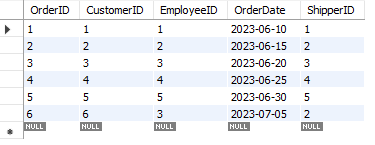
List Employees with Higher Than Average Number of Orders
employees Table:

Orders Table:

● SELECT Employees.EmployeeID, CONCAT(Employees.FirstName, ' ', Employees.LastName) AS FullName, COUNT(Orders.OrderID) AS OrderCount
Retrieves the Employee ID, full name (by combining first and last names), and the total number of orders handled by each employee.
● FROM Employees
Starts from the Employees table.
● JOIN Orders ON Employees.EmployeeID = Orders.EmployeeID
Joins the Orders table with Employees using the EmployeeID field to match employees with their orders.
● GROUP BY Employees.EmployeeID, FullName
Groups the result set by each employee to calculate order count individually.
● HAVING COUNT(Orders.OrderID) > ( ... )
Filters the grouped results to include only those employees who processed more than the average number of orders.
● Subquery: (SELECT AVG(OrderCount) FROM (...))
This inner subquery calculates the average number of orders per employee.
- First, it counts orders per employee.
- Then, it calculates the average from those counts.
SQL Query:
SELECT Employees.EmployeeID,
CONCAT(Employees.FirstName, ' ', Employees.LastName) AS FullName,
COUNT(Orders.OrderID) AS OrderCount
FROM Employees
JOIN Orders ON Employees.EmployeeID = Orders.EmployeeID
GROUP BY Employees.EmployeeID, FullName
HAVING COUNT(Orders.OrderID) > (
SELECT AVG(OrderCount) FROM (
SELECT COUNT(*) AS OrderCount
FROM Orders
GROUP BY EmployeeID
) AS AvgSubquery
);
Output:


Trainings :
Python and Django Training in Indore | UI UX Design Training in Indore | DevOps Training in Indore | Python + DSA Training in Indore | Data Science Training in Indore | Web Development Training in Indore | Full Stack Development Training in Indore | Data Analytics Training in Indore |Free Courses and Resource :
Verbal Aptitude | Matplotlib Tutorials | Examples | Interview Questions | Pandas Tutorials | Projects | Interview Questions | OpenCV Tutorials | Projects | Interview Questions | ExpressJS Tutorials | Projects | Interview Questions | Dart | Python Data Structures and Algorithms | Rust Tutorials | Projects | Interview Questions | Aptitude Tests | HackerRank Python | Django | MongoDB Tutorials | Examples | Interview Questions | NumPy Practice Questions | Python Tutorials by CodersDaily | Golang Tutorials | Projects | Interview Questions | React.js Tutorials | Verbal Ability Tutorial | MS Sql Server Tutorials | Examples | Interview Questions | Power BI Tutorials | Projects | Interview Questions | Example Dashboards | Numpy Tutorials | Projects | Interview Questions | Django REST Framework Tutorial | HackerRank C++ Solutions | Pandas Practice Questions | Tensor Flow | Python Practice Questions | C++ Tutorials | Quantitative Ability Tutorial | Google Sheets Mastery: From Basics to Dashboards | Langchain Tutorials | Javascript | Node.js Tutorials | HackerRank SQL Solutions | HackerRank DSA Solutions | Verbal Aptitude 2 | HackerRank Java Solutions | HTML Tutorial | TCS NQT Mock Test Series | Reasoning Ability Tutorial | CodeChef Python Solutions | HackerRank C Program Solutions | Leetcode Python Solutions | SQL Practice Question | Matplotlib Practice Questions |Interview Questions :
Pandas Tutorials | Projects | Interview Questions | ExpressJS Tutorials | Projects | Interview Questions | Django | Python Tutorials by CodersDaily | Golang Tutorials | Projects | Interview Questions | Numpy Tutorials | Projects | Interview Questions | Django REST Framework Tutorial | Matplotlib Practice Questions | Matplotlib Practice Questions | Matplotlib Practice Questions | Matplotlib Practice Questions | Matplotlib Practice Questions | Matplotlib Practice Questions | Matplotlib Practice Questions | Matplotlib Practice Questions | Matplotlib Practice Questions | Matplotlib Practice Questions |Top Colleges in India :
Indian Institute of Technology Bombay | Jaypee University of Engineering and Technology - Guna |